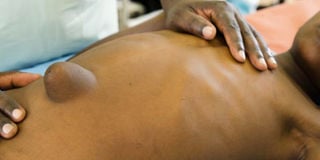What you should know about hernia disorder

A child with an umbilical hernia. The condition is common in children and if left untreated, hernias can cause pain and other health complications.
On a recent television programme, a doctor was discussing hernia, a common disorder that is rarely talked about, but which affects many children. One of the risk factors for this condition, according to the doctor is over-crying. But what exactly causes hernia in children?
Dr Sarah Bonita Musoke, a paediatrician at International Hospital Kampala, says hernia is a condition in which body organs such as the intestines may push through an opening, or the weak point of the abdominal muscles.
Types of hernia
Inguinal and umbilical hernias are the most common type of this condition. Inguinal hernia is a condition in which part of the intestine may protrude through an opening or a weak spot in the groin.
Boys are more prone to this kind of hernia because their testicles develop in the abdomen, and move down to the scrotum through the abdominal canal. The canal is usually open during the growth of the child in the womb, and closes shortly before birth.
When the canal does not close, it makes a pathway for internal abdominal organs to come out through the weak point causing on-and-off swelling of the scrotum or groin. This type of hernia commonly happens on the right side of the canal
Dr Musoke says inguinal hernia is rare in girls, although few may develop it. “Adults can also suffer from inguinal hernia, especially when their risk for factors that increase pressure in the abdominal cavity such as chronic cough, tuberculosis, muscle build-up and lifting of heavy loads is high,” says Dr Musoke.
Inguinal hernia makes up about 70 per cent of all hernias, according to the British Hernia Centre (BHC). While common in children, Dr Musoke says inguinal hernia can as well develop later in life, when muscles weaken or deteriorate due to factors such as aging, engaging in strenuous physical activities and smoking.
On the other hand, umbilical hernia can affect both children and adults. “In children umbilical hernia occurs when the part of the intestine protrudes through an opening in the abdominal muscles,” says Dr Musoke. She says umbilical hernias also occur when the abdominal muscles do not fully develop, leaving a defect in the tissue.
The intestine may bulge through the abdominal muscles, which is visible when a child cries, resulting in swelling of the umbilicus. In adults, hernia risk factors include chronic constipation, cough, age, obesity and pregnancy that put pressure on the abdomen.
Treatment
About 90 per cent of umbilical hernias heal on their own by the time a child turns three. Wrapping the umbilical cord with a clean cloth can help suppress the swelling. Umbilical hernias are usually painless and do not require surgery.
On the other hand, inguinal hernias require immediate treatment after a diagnosis. Dr Musoke says any swelling that occurs around the umbilical cord, groin or scrotum should be a cause for concern, and parents should seek medical advice.




